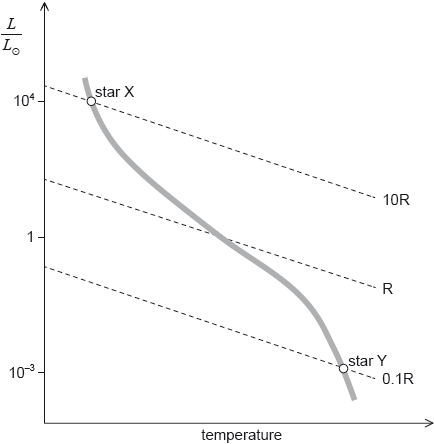| Date | May 2019 | Marks available | 1 | Reference code | 19M.3.SL.TZ2.15 |
| Level | Standard level | Paper | Paper 3 | Time zone | 2 |
| Command term | Outline | Question number | 15 | Adapted from | N/A |
Question
The Hertzsprung-Russell (HR) diagram shows several star types. The luminosity of the Sun is L☉.
Identify, on the HR diagram, the position of the Sun. Label the position S.
Suggest the conditions that will cause the Sun to become a red giant.
Outline why the Sun will maintain a constant radius after it becomes a white dwarf.
During its evolution, the Sun is likely to be a red giant of surface temperature 3000 K and luminosity 104 L☉. Later it is likely to be a white dwarf of surface temperature 10 000 K and luminosity 10-4 L☉. Calculate the .
Markscheme
the letter S should be in the region of the shaded area ✔
the fusion of hydrogen in the core eventually stops
OR
core contracts ✔
the hydrogen in a layer around the core will begin to fuse ✔
Sun expands AND the surface cools ✔
helium fusion begins in the core ✔
Sun becomes more luminous/brighter✔
Ignore any mention of the evolution past the red giant stage
electron degeneracy <<prevents further compression>> ✔
Ignore mention of the Chandrasekhar limit.
Award [0] for answer mentioning radiation pressure or fusion reactions.
Examiners report
Locating the Sun’s position on the HR diagram was correctly done by most candidates, although a few were unsure of the surface temperature of the Sun.
The evolution of a main sequence star to the red giant region is reasonably well understood. However many struggled to find three different facts to describe the changes. Answers were often too vague, when writing about a change in temperature or size of a star, the candidates are expected to mention whether they are referring to the core or the surface/outer layer. A surprising number of candidates wrote that the Sun must be less than eight solar masses.
The mention of electron degeneracy pressure was fairly common, but incorrect answers were even more common at SL.
Calculating the ratio of the radius of a white dwarf to a red giant star was done quite well by most candidates. However quite a few candidates made POT errors or forgot to take the final square root.


